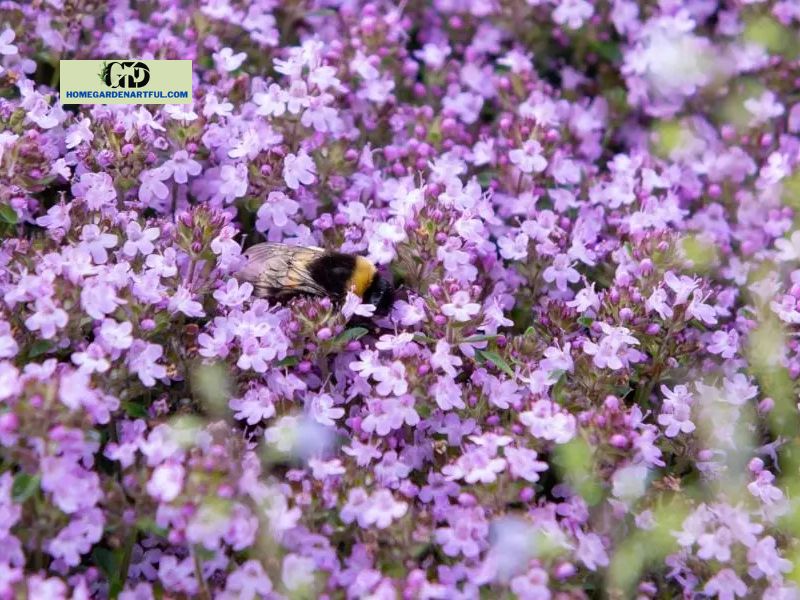Is Creeping Thyme Invasive? Let’s talk about creeping Thyme, a perennial plant. Don’t worry, there’s nothing creepy about it — they acquired their moniker from their movement patterns! These tiny creepers are frequently used as ground coverings to shade sunny areas of the garden.
Many gardeners are drawn to the gorgeous purple hue of creeping thyme, but they are frequently hesitant to plant it in their gardens for fear of it becoming invasive and smothering the rest of their plants.
Although they have distinct growth patterns, this does not necessarily imply that they will become invasive.
Continue reading at homegardenartful.com to find out if creeping thyme is invasive and much more!
Is Creeping Thyme Invasive?
To determine if creeping thyme is invasive, we must first examine its growth tendencies.
The truth is that when you plant creeping thyme, it will spread swiftly throughout the garden. This is due to the plant’s ability to replicate itself by projecting stolons along the ground or sprouting roots (rhizomes) beneath the ground.
You will need to clip the plant to keep its shape from time to time, but you won’t need to mow it because creeping thyme only grows to be 2 inches tall!
Creeping thyme is an excellent ground cover since it can withstand foot activity, making it ideal for families with children and pets. Furthermore, because of its wonderful aroma, it can be used as a garden perfume.
So, to cut to the chase, is creeping thyme invasive?
The answer is no; while it will spread quickly in a garden, it will not harm other plants. As a result, if you want a lovely ground cover that also smells pleasant and is resistant to deer and rabbits, you should definitely consider creeping thyme!
What You Should Know About Creeping Thyme
Creeping thyme, frequently referred to as Thymus serpyllum, is a perennial plant in the Lamiaceae mint family. When we say a plant is perennial, we mean that it grows back year after year!
This is a thyme variety since we know that thyme is frequently used in cooking, so planting creeping thyme will provide you with a lovely ground cover as well as a new spice for cooking!
This plant produces lovely flowers in a variety of hues. They normally have purple or pink blooms, although some types have white flowers as well. These look excellent against dark green leaves in the backdrop.
These blooms attract pollinators and are particularly beneficial to butterflies. The creeping thyme blooms are home to two types of butterflies: the small blue butterfly and the huge blue butterfly. After feasting on the leaves, the larvae will grow into adult butterflies.
Creeping thyme can be grown in USDA zones 4 through 9, though this varies depending on the cultivar.
Creeping thyme plants are excellent for embellishing your rock garden, walkways, as well as stepping stones, but they may also be utilized as a border plant in your garden because they prevent deer and rabbits.
Creeping Thyme Planting Instructions
When planting creeping thyme, there are a few things to keep in mind. Though this plant may grow in a variety of environments, it favors well-drained, nutrient-rich, loamy soil.
It may, however, grow in a variety of soil types, especially sand and rocky soil. They prefer alkaline soil, therefore verify the pH levels before planting.
Creeping thyme can be grown from seed or cuttings.
If you wish to plant the cuttings, take them in early summer; however, if you want to grow the plant from seeds, start the seeds indoors in early spring.
Once the seeds have sprouted, move your new creeper to the garden, but make sure the latest frost date has passed.
Creeping Thyme Growing Instructions
You don’t have to worry about plant care if you grow creeping thyme in the correct climate because it’s known for growing highly resilient and low-maintenance.
Light
Because they can thrive in full sun, we primarily employ these plants as ground coverings. These plants come from hot Mediterranean locations where they have adapted to flourish in full sun all day!
As a result, if you want to use creeping thyme as a ground cover plant, make sure to put it in a sunny spot in your garden. Don’t worry if your entire garden isn’t exposed to the sun; they can still grow in partial shade.
Soil
As previously said, these plants thrive in well-drained, loose soil. They can be grown in sand, loam, or even rocky soil.
Creeping thyme grows well in dry soil and dislikes moist soil. Though thyme grows more quickly in fertile soil, it may also flourish in poor soil.
Water
When it comes to watering requirements, new plants require greater care because they demand frequent watering. These plants are drought-tolerant once established, so you won’t have to water them every day.
If you keep watering these plants, the soil will become overly wet, which might lead to root rot. Overwatering causes root rot, a fungal disease that can entirely destroy your plant.
Fertilizer
Creeping thyme should not need to be fed if the soil is adequately prepared.
However, at the start of the growth season, you should consider using slow-release fertilizer. The nutrients will be supplied continually throughout the season, encouraging lush foliage and flowers.
Temperature and Humidity
Because these plants are not frost-hardy, you should not transfer them outside until late spring or early summer. When you successfully transplant creeping thyme outside, you will find that it spreads and grows quickly.
Conclusion
The answer to the topic “Is creeping thyme invasive?” is now known. It’s a resounding no, so you may grow creeping thyme as an ornamental plant in your garden without worrying about it interfering with the rest of your plants.
Creeping thyme is an excellent choice for garden decoration since it produces an abundance of tiny, colorful flowers that smell amazing!

